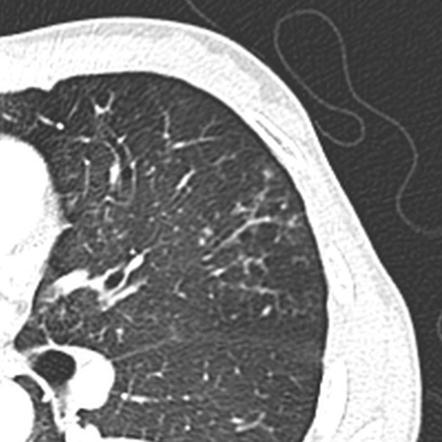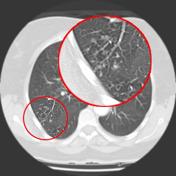tree in bud opacities causes
Diffuse panbronchiolitis is an exudative bronchiolitis. Histopathologic studies have shown that the tree-in-bud pattern is caused by demarcation of the normally invisible branching course of the peripheral airways which usually results from bronchioles being plugged or blocked with mucus pus or fluid.

Hrct Scan Of The Chest Showing Diffuse Micronodules And Tree In Bud Download Scientific Diagram
3A 3B a condition that develops in approximately 5 of patients with primary infection and is frequently associated with malnutrition and immune suppression.
. What causes tree in bud opacities. Aspiration was the cause in 42 of 166 25. What causes tree in.
A young male patient who had a history of fever cough and respiratory distress presented in the emergency department. Tree in bud opacities icd 10. Causes for TIB opacities were established in 166 of 406 409 cases.
In the hospital MTB cannot be missed. Found that the tree-in-bud pattern was seen in 256 of the CT scans in patients with bronchiectasis. Bronchiolitis is characterized at thin-section CT by the presence of centrilobular nodules and linear branching opacities producing a tree-in-bud appearance Fig 7 4.
Bronchiectasis which may be of any cause can produce the tree-in-bud pattern. Tree-in-bud TIB appearance in computed tomography CT chest is most commonly a manifestation of infection. Fungal hyphae are often found in the airway lumen Fig 7c.
Another important entity that can produce the tree-in-bud pattern is bronchioalveolar carcinoma BAC. The purpose of this study was to. As you can see the possible causes of a tree in bud appearance are legion.
Respiratory infections 119 of 166 72 with mycobacteria 65 of 166 39 bacteria 44 of 166 27 viruses four of 166 3 or multiple organisms six of 166 4 were most common. Causes for TIB opacities were established in 166 of 406 409 cases. Causes for TIB opacities were established in 166 of 406 409 cases.
Respiratory infections cause about 72 of cases with 39 due to Mycobacterial cases 27 due to other bacteria and 3 due to viruses. The purpose of this study was to determine the relative frequency of causes of TIB opacities and identify patterns of disease associated with TIB opacities. The pattern of the tree correlates to an intralobular inflammatory bronchiole and the bud correlates to inflammatory filling in alveolar ducts.
The classic cause of the tree-in-bud pattern is postprimary tuberculosis Fig. However to our knowledge the relative frequencies of the causes have not been evaluated. Multiple causes for tree-in-bud TIB opacities an imaging pattern usually seen on chest CT have been reported.
The main causes of tree-inbud findings in the general population are reported to be acute or chronic infections mainly from nontuberculous mycobacteria and. We here describe an unusual cause of TIB during the COVID-19 pandemic. 8081 On CT the tree-in-bud pattern manifests as small 24 mm centrilobular well-defined nodules connected to linear branching opacities that.
The causes of TIB opacities. Tree-in-bud TIB appearance in computed tomography CT chest is most commonly a manifestation of infection. 2 However the classic cause of tree-in-bud is Mycobacterium tuberculosis especially when it is active and contagious and associated with cavitary lesions.
Causes for TIB opacities were established in 166 of 406 409 cases. Respiratory infections 119 of 166 72 with mycobacteria 65 of 166 39 bacteria 44 of 166 27 viruses four of 166 3 or multiple organisms six of 166 4 were most common. Mycobacterium avium complex is the most common cause in most series.
Respiratory infec-tions 119 of 166 72 with mycobacteria 65. Uncommonly this pattern can be seen in other entities that cause luminal impaction bronchiolar dilatation or wall thickening including cystic fibrosis immune deficiency inflammatory bowel disease and diffuse panbronchiolitis. The differential diagnosis of tree-in-bud nodules includes infection and aspiration the two most common causes as well as congenital airway diseases allergic bronchopulmonary aspergillosis follicular bronchiolitis panbronchiolitis intravenous injection of foreign material and intravascular tumor emboli.
Intravascular pulmonary tumor embolism often occurs in cancers of the breast liver kidney stomach prostate and ovaries and. Respiratory infections 119 of 166 72 with mycobacteria 65 of 166 39 bacteria 44 of 166 27 viruses four of 166 3 or multiple organisms six of 166 4 were most common. Aspiration was the cause in 42 of 166 25.
Patterns of disease associated with TIB opacities were evalu ated. The tree-in-bud sign can be commonly caused by respiratory infections including that of mycobacterial bacterial and viral causes. The main causes of tree-inbud findings in the general population are reported to be acute or chronic infections mainly from nontuberculous mycobacteria and.
Where there is small airways disease and tree in bud is present this can be termed an exudative bronchiolitis. Multiple causes for tree-in-bud TIB opacities have been reported.

Tree In Bud Pattern Radiology Case Radiopaedia Org

Tree In Bud Sign Lung Radiology Reference Article Radiopaedia Org

References In Causes And Imaging Patterns Of Tree In Bud Opacities Chest

Tree In Bud Sign Lung Radiology Reference Article Radiopaedia Org
View Of Tree In Bud The Southwest Respiratory And Critical Care Chronicles

Tree In Bud Pattern Radiology Case Radiopaedia Org

Chest Ct With Multifocal Tree In Bud Opacities Diffuse Bronchiectasis Download Scientific Diagram

Tree In Bud Almost Always Indicates The Presence Of Endobronchial Grepmed

References In Causes And Imaging Patterns Of Tree In Bud Opacities Chest

References In Causes And Imaging Patterns Of Tree In Bud Opacities Chest

Tree In Bud Sign Lung Radiology Reference Article Radiopaedia Org


